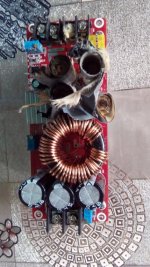Thank you for the insight.
The Drok driver does say it has CC/CV capabilities?? Maybe I am reading it wrong, but there is an individual POT each for CC and CV.
Is 100-200mv ripple bad? I would assume it would be an issue for a single diode, but over 20 diodes it seems no problem to me. I was testing from 80V to 85V Constant Voltage, and the Power draw of the NUBM31T was quite linear. This was the same to NUBM44(7W) single diode, it was quite linear. I believe modern 445nm diodes 5W+ are different from the traditional diodes. They almost behave like LEDs in terms of forward voltage curve.
When you say "sensitive" Do you mean slight changes in Vin would have large amperage draw effects? Or maybe life expectancy due to voltage spikes, etc?
If I were to use the Drok converter as the driver, what would the potential issues be compared to a "true laser driver"
Examples;
-Voltage fluctuations causing laser diode to wear out.
-Efficiency of "85%" compared to real drivers at "97%"
The reason why I want to avoid using 4 separate buck drivers is because I want to control output with a single manual POT. I wouldn't know how to control 4 drivers with a single pot without having to make a custom PCB.
I don't need clean PWM/TTL pulsing required for laser etching or other similar purposes. I would just turn it on and adjust the current as needed.
I really want to use the DROK driver since it will save me so much time. I looked for hours and was ready to pay up to 1000USD for a driver and nothing was suitable.
I am open to commission a driver to be design and made, but not many people out there would be willing. If I could customize, I wanted to add thermocouples, etc to have even higher safety.
Is there anything wrong if I were to add a 4/5A fuse inline with a driver to protect incase of anything?
I have (accidentally by killing a live-lasersystems.net driver) tested on the nubm31t with short bursts up to 8A and it did not die.
The Drok driver does say it has CC/CV capabilities?? Maybe I am reading it wrong, but there is an individual POT each for CC and CV.
Is 100-200mv ripple bad? I would assume it would be an issue for a single diode, but over 20 diodes it seems no problem to me. I was testing from 80V to 85V Constant Voltage, and the Power draw of the NUBM31T was quite linear. This was the same to NUBM44(7W) single diode, it was quite linear. I believe modern 445nm diodes 5W+ are different from the traditional diodes. They almost behave like LEDs in terms of forward voltage curve.
When you say "sensitive" Do you mean slight changes in Vin would have large amperage draw effects? Or maybe life expectancy due to voltage spikes, etc?
If I were to use the Drok converter as the driver, what would the potential issues be compared to a "true laser driver"
Examples;
-Voltage fluctuations causing laser diode to wear out.
-Efficiency of "85%" compared to real drivers at "97%"
The reason why I want to avoid using 4 separate buck drivers is because I want to control output with a single manual POT. I wouldn't know how to control 4 drivers with a single pot without having to make a custom PCB.
I don't need clean PWM/TTL pulsing required for laser etching or other similar purposes. I would just turn it on and adjust the current as needed.
I really want to use the DROK driver since it will save me so much time. I looked for hours and was ready to pay up to 1000USD for a driver and nothing was suitable.
I am open to commission a driver to be design and made, but not many people out there would be willing. If I could customize, I wanted to add thermocouples, etc to have even higher safety.
Is there anything wrong if I were to add a 4/5A fuse inline with a driver to protect incase of anything?
I have (accidentally by killing a live-lasersystems.net driver) tested on the nubm31t with short bursts up to 8A and it did not die.







